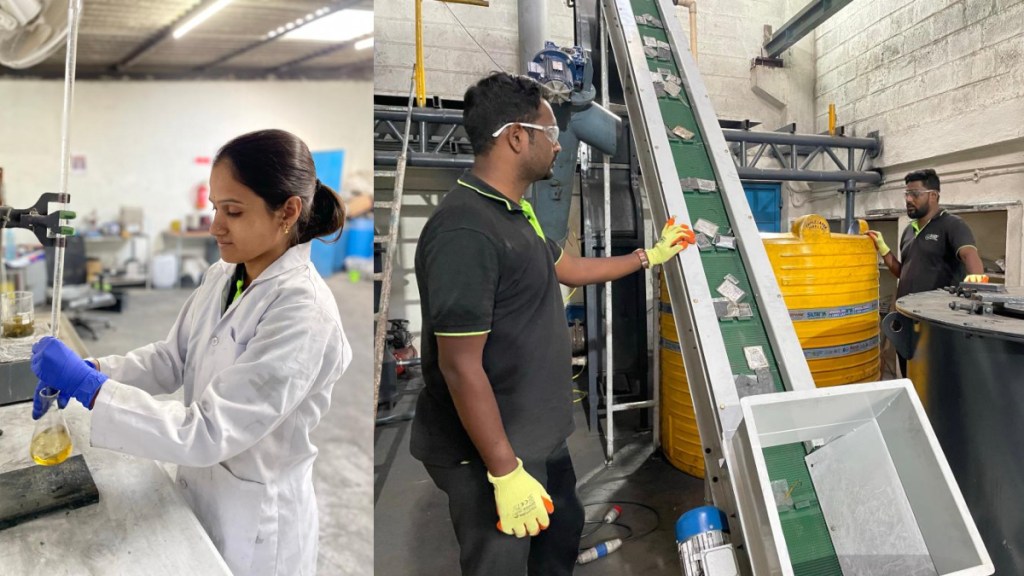By Shubham Vishvakarma
Lithium-ion batteries (LIBs) have emerged as a game-changing invention in the field of sustainable energy and storage technologies, attracting widespread attention. They are vital for sustainable energy solutions, powering consumer electronics and electric vehicles (EVs). And as the LIBs grow in popularity, their demand graph grows proportionally. But the staggering surge in demand for the batteries has posed challenges related to raw material scarcity driven by the depletion of natural resources.
This further emphasises the need for efficient recycling methods to preserve the valuable resources, which went into manufacturing the LIBs and would otherwise be wasted. As India expands its EV industry, a focus on diverse technologies is essential to ensure a stable and sustainable LIB supply chain. This article explores various recycling processes and technologies, each offering unique approaches to address raw material scarcity and environmental concerns.
Understanding LIB composition
A single LIB cell consists of a cathode, an anode, a separator that also contains the electrolyte, and robust housing. While any cells, interconnected in series, in parallel, or a combination of the two, are usually assembled into battery modules with the desired voltage and capacity. Depending on the requirements of the intended application, LIBs may vary in shape, size, capacity, and configuration. However, the most widely accepted classification of the LIB types is based on the cathode material. Cathode materials, including lithium cobalt oxide (LiCoO2) and lithium iron phosphate (LiFePO4), exhibit variations. Many of these elements are classified as critical raw materials, emphasising the need to reintroduce end-of-life batteries and their components back into the economic cycle and reduce the need for primary raw materials. As India’s EV industry diversifies, recycling initiatives must be adaptable to handle the evolving landscape of battery types and chemistries.
Economic considerations
Now comes the economic viability of LIB recycling, which hinges on battery chemistry, raw material prices, and processing costs. India is actively working towards streamlining adaptable processes, considering factors like higher nickel content in EV batteries and cost preferences for certain cathodes. The goal is to maximise the extraction of value from spent batteries, understanding that the salvage value of certain battery chemistries might be negative.
Efficient pre-treatment processes
Ensuring safe battery disassembly is also a critical step in the recycling process. Discharging methods encompass thermal treatments, salt-water baths, and mechanical pre-treatment involving shredding and crushing. Investment in advanced pre-treatment technologies is crucial for managing the diverse range of batteries present in the market.
Mechanical recycling
Mechanical processing serves as an initial step in LIB recycling, involving disassembly, shredding, grinding, and crushing. Despite its simplicity, this process produces a black mass that requires further refining via hydrometallurgical or pyrometallurgical processing. Many recyclers in Europe and North America predominantly employ mechanical recycling, often transporting the black mass to the Asia-Pacific for additional processing capabilities.
Pyrometallurgical Recycling
Pyrometallurgy utilises heat to extract battery materials, making it suitable for various metal-containing waste streams. Despite its advantages, such as minimal pretreatment requirements and versatility with different battery chemistries, pyrometallurgy comes with high capital and energy requirements. It produces a mixed metal alloy whereas lithium is typically lost in a slag stream, necessitating further hydrometallurgical processing for metal extraction. India must carefully weigh the advantages and drawbacks before considering the adoption of pyrometallurgical methods.
Hydrometallurgical Recycling
Hydrometallurgical techniques either recycle black mass directly or refine alloys from pyrometallurgy, yielding metal salts. While offering benefits such as greater recovery of valuable metals and lower energy intensity, hydrometallurgical recycling requires meticulous consideration of reagent costs and water consumption. The majority of hydrometallurgical recycling capacity currently resides in the Asia-Pacific region, with potential for expansion in Europe and the US. However, challenges include high costs, scalability issues, substantial resource consumption, and the generation of toxic gases during the process.
Direct recycling
A pre-commercialised technique that involves mechanical pre-processing, component separation, and reactivation of battery materials without breaking down the crystal structure. However, this is a pre-commercialised technology being investigated by research bodies on a more lab-scale basis.
Integrated Carbothermal Reduction
Integrated Carbothermal Reduction is a chemical-free, low-carbon method for end-to-end treatment of Li-ion batteries. This scalable process eliminates the use of chemical inputs, extracting critical minerals in their commodity metal form.
Design for circularity
As the EV industry continues to evolve, a ‘design for recycling’ approach becomes crucial. Standardised cell designs and specific battery chemistries simplify processes for all recycling methods. India’s EV industry has the rare opportunity to be cognisant of past failures of other industries and design appropriately when the industry is in the cradle stage.
India’s rapidly growing EV industry demands a comprehensive and sustainable approach to lithium-ion battery recycling. Evaluating various processes and technologies is crucial for ensuring a secure LIB supply chain. By fostering a collaborative environment for future developments and implementing efficient recycling methods, India can lead the way in creating a circular battery economy, mitigating environmental impact, and reducing reliance on primary raw materials.
The author is Co-Founder and Chief of Process Engineering, Metastable Materials.
Disclaimer: The views and opinions expressed in this article are solely those of the original author. These views and opinions do not represent those of The Indian Express Group or its employees.



















